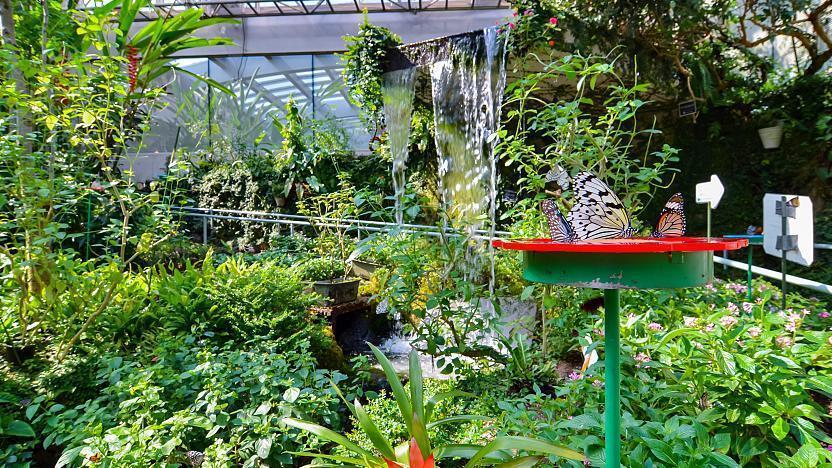
Hakusan City (白山市, Hakusan-shi) is named after Mount Hakusan, the highest mountain in the region. Located just south of Kanazawa, the city includes the densely populated city center along the Sea of Japan coast, rural valleys further inland and the peak of Mount Hakusan. The majority of tourist spots are found in the mountainous areas, including hiking trails, snow resorts, museums and hot springs.
The city's main attraction is Mount Hakusan, the 2702 meter tall dormant volcano that lies far outside of Hakusan City's center along the border between Ishikawa and Gifu prefectures. It is one of the tallest mountains in western Japan and one of the country's "three holiest mountains" (alongside Mount Fuji and Mount Tateyama). Its attractive hiking trails attract nature lovers in summer and autumn.

Shiramine Onsen is a small hot spring town at the base of Mount Hakusan consisting of a collection of hotels, ryokan and minshuku around a large public bath at the center of town. The renovated bath has a nice traditional feel with a variety of wooden indoor baths and a small stone outdoor bath for each gender. Shiramine Onsen is the last sizable village along the road to the hiking trails and is a convenient base from which to climb the mountain.
Among several small ski resorts further north towards the city center is the entrance to the Hakusan Super Rindo, a winding toll road that leads through the high mountains to Shirakawa-go in Gifu Prefecture. The road is open from mid June to mid November and offers panoramic views of the surrounding mountains and valleys.

Many of Hakusan City's smaller attractions are found around Tsurugi Station, the last stop on the Hokuriku Railroad (Hokutetsu) that connects Hakusan City to Kanazawa. About a 20 minute walk from the station lies the Ishikawa Insect Museum, an excellent insectarium with a variety of live exhibits and hands on experiences with Japanese insects. The museum also has an extensive collection of mounted insects from around the world and a beautifully designed butterfly house.
Just a few minutes further down the road lies Shirayamahime Shrine, the main shrine of the powerful Kaga Domain that encompassed the region during the Edo Period (1603-1868). The shrine is dedicated to the worship of Mount Hakusan (Shirayama is an alternate reading of Hakusan), which has long been an important religious symbol in the region. Shirayamahime Shrine has a satellite shrine (Okumiya) located at the summit of Mount Hakusan.

East of Tsurugi Station along the steep walls of the valley, lies a 650 meter high recreational area called the Shishiku Highland. The highland is connected to the town below by a gondola and offers camping, barbecue pits, a restaurant, hiking, golf cart rides and a short ski hill. It also serves as the launching point for paragliding.
The Tedori River, which snakes its way through Hakusan Town, has cut the narrow Tedori Gorge deep into the flat valley floor a few kilometers upstream from Tsurugi Station. Several bridges cross the river and give brief glimpses down into the gorge, while a few trails lead down the steep rock walls to the water below. Rafting tours operate in the summer and offer a water level view of the gorge's high walls and cascading waterfalls.

Getting there and around
Hakusan City's center is located along the Sea of Japan around Matto Station. However, most of the city's tourist attractions are found further inland up in the mountains. Because public transportation is rather inconvenient in the mountains, a rental car is the recommended means to get around outside of winter. Rental car outlets can be found in Kanazawa, at Kaga Onsen Station and Komatsu Airport.
Trains go as far as Tsurugi Station partway into Hakusan City. Take the IR Ishikawa Railway from Kanazawa (3 minutes, 220 yen, 2-3 departures per hour) to Nishi-Kanazawa Station, and transfer to the Hokuriku Railroad (Hokutetsu) at nearby Shin-Nishi-Kanazawa Station for Tsurugi Station (25 minutes, 540 yen, 1-2 departures per hour). Alternatively you can take the Hokuriku Railroad directly from Nomachi Station near Kanazawa's Nishi Chaya District to Tsurugi Station (30 minutes, 540 yen). The IR Ishikawa Railway and Hokuriku Railroad are not covered by the Japan Rail Pass.

From Tsurugi Station it is a 20 to 40 minute walk to the Insect Museum, Shiramine Shrine and the Shishiku Ropeway. Infrequent buses from Kanazawa Station stop at Tsurugi Station before continuing on to multiple stops along the Tedori Gorge and terminating in Shiramine Onsen further back in the mountains. In addition, hiking buses operate on selected days during the climbing season.
How to get to and around Kaga Onsen and Hakusan

Hours and Fees
Insect Museum
Hours
Closed
December 29 to January 1
Admission
Shirayamahime Shrine
Hours
Closed
Admission
Shishiku Highland Ropeway
Hours
Closed
Admission
Shiramine Onsen Soyu Public Bath
Hours
Closed
Admission
Questions? Ask in our forum.
Links and Resources
Hotels around Kaga Onsen
-
-
![]() Araya TotoanGenuine traditional ryokan in the heart of Yamashiro Onsen. Enjoy the refined cuisine with its esthetic tranquility. Complementary shuttle from JR Kaga Onsen Sta.View siteSponsored
Araya TotoanGenuine traditional ryokan in the heart of Yamashiro Onsen. Enjoy the refined cuisine with its esthetic tranquility. Complementary shuttle from JR Kaga Onsen Sta.View siteSponsored -
![]() Tachibana ShikiteiEstablished in 1868, Tachibana Shikitei in the center of Yamashiro Onsen offers authentic Japanese hospitality. A spacious room with private onsen available.View siteSponsored
Tachibana ShikiteiEstablished in 1868, Tachibana Shikitei in the center of Yamashiro Onsen offers authentic Japanese hospitality. A spacious room with private onsen available.View siteSponsored -
![]() Yoshidaya SannoukakuA traditional ryokan on a tranquil hill in Yamashiro. Enjoy in-room private onsen bath and local fresh specialties. Free shuttle provided to/from JR Kaga Sta.View siteSponsored
Yoshidaya SannoukakuA traditional ryokan on a tranquil hill in Yamashiro. Enjoy in-room private onsen bath and local fresh specialties. Free shuttle provided to/from JR Kaga Sta.View siteSponsored
-





